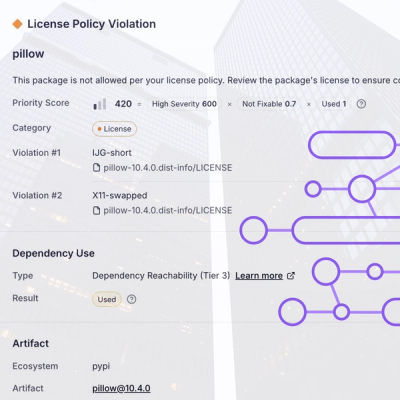
Research
/Security News
Critical Vulnerability in NestJS Devtools: Localhost RCE via Sandbox Escape
A flawed sandbox in @nestjs/devtools-integration lets attackers run code on your machine via CSRF, leading to full Remote Code Execution (RCE).
The columnify npm package is a utility that allows for formatting console output into a columnar data format. It is particularly useful for creating readable tables out of JSON data or arrays of objects. With columnify, you can easily align text in columns, customize column widths, and manage how text wraps within columns.
Basic Column Formatting
This feature allows for the simple transformation of an array of objects into a neatly formatted table. Each object property becomes a column.
const columnify = require('columnify')
const data = [{ name: 'John', age: 22 }, { name: 'Jane', age: 33 }]
console.log(columnify(data))Custom Column Widths
This feature enables the customization of column widths, allowing for a uniform appearance or to accommodate longer text without breaking the layout.
const columnify = require('columnify')
const data = [{ name: 'John', age: 22 }, { name: 'Jane', age: 33 }]
console.log(columnify(data, { minWidth: 20 }))Column Alignment
This feature allows for the alignment of text within columns. In this example, the 'age' column is right-aligned, enhancing the readability of numerical data.
const columnify = require('columnify')
const data = [{ name: 'John', age: 22, location: 'New York' }, { name: 'Jane', age: 33, location: 'California' }]
console.log(columnify(data, { config: { age: { align: 'right' } } }))cli-table is a similar package that provides functionalities for rendering unicode-aided tables on the command line. Compared to columnify, cli-table offers more customization options for borders and styles but might require more setup for simple tasks.
The 'table' package is another alternative that allows for creating text-based tables with customizable padding, margin, and border styles. It supports content wrapping and column width management similar to columnify but with additional features like text truncation and alignment.
Create text-based columns suitable for console output from objects or arrays of objects.
Columns are automatically resized to fit the content of the largest cell. Each cell will be padded with spaces to fill the available space and ensure column contents are left-aligned.
Designed to handle sensible wrapping in npm search results.
npm search before & after integrating columnify:

$ npm install columnify
var columnify = require('columnify')
var columns = columnify(data, options)
console.log(columns)
Objects are converted to a list of key/value pairs:
var data = {
"commander@0.6.1": 1,
"minimatch@0.2.14": 3,
"mkdirp@0.3.5": 2,
"sigmund@1.0.0": 3
}
console.log(columnify(data))
KEY VALUE
commander@0.6.1 1
minimatch@0.2.14 3
mkdirp@0.3.5 2
sigmund@1.0.0 3
var data = {
"commander@0.6.1": 1,
"minimatch@0.2.14": 3,
"mkdirp@0.3.5": 2,
"sigmund@1.0.0": 3
}
console.log(columnify(data, {columns: ['MODULE', 'COUNT']}))
MODULE COUNT
commander@0.6.1 1
minimatch@0.2.14 3
mkdirp@0.3.5 2
sigmund@1.0.0 3
Column headings are extracted from the keys in supplied objects.
var columnify = require('columnify')
var columns = columnify([{
name: 'mod1',
version: '0.0.1'
}, {
name: 'module2',
version: '0.2.0'
}])
console.log(columns)
NAME VERSION
mod1 0.0.1
module2 0.2.0
By default, all properties are converted into columns, whether or not they exist on every object or not.
To explicitly specify which columns to include, and in which order, supply a "columns" or "include" array ("include" is just an alias).
var data = [{
name: 'module1',
description: 'some description',
version: '0.0.1',
}, {
name: 'module2',
description: 'another description',
version: '0.2.0',
}]
var columns = columnify(data, {
columns: ['name', 'version']
})
console.log(columns)
NAME VERSION
module1 0.0.1
module2 0.2.0
You can set a number of options at a global level (ie. for all columns) or on a per column basis.
Set options on a per column basis by using the config option to specify individual columns:
var columns = columnify(data, {
optionName: optionValue,
config: {
columnName: {optionName: optionValue},
columnName: {optionName: optionValue},
}
})
As with all options, you can define the maxWidth and minWidth globally, or for specified columns. By default, wrapping will happen at word boundaries. Empty cells or those which do not fill the minWidth will be padded with spaces.
var columns = columnify([{
name: 'mod1',
description: 'some description which happens to be far larger than the max',
version: '0.0.1',
}, {
name: 'module-two',
description: 'another description larger than the max',
version: '0.2.0',
}], {
minWidth: 20,
config: {
description: {maxWidth: 30}
}
})
console.log(columns)
NAME DESCRIPTION VERSION
mod1 some description which happens 0.0.1
to be far larger than the max
module-two another description larger 0.2.0
than the max
You can set a hard maximum line width using the maxLineWidth option.
Beyond this value data is unceremoniously truncated with no truncation
marker.
This can either be a number or 'auto' to set the value to the width of stdout.
Setting this value to 'auto' prevent TTY-imposed line-wrapping when lines exceed the screen width.
You can disable wrapping and instead truncate content at the maximum
column width by using the truncate option. Truncation respects word boundaries. A truncation marker, …, will appear next to the last word in any truncated line.
var columns = columnify(data, {
truncate: true,
config: {
description: {
maxWidth: 20
}
}
})
console.log(columns)
NAME DESCRIPTION VERSION
mod1 some description… 0.0.1
module-two another description… 0.2.0
You can set the alignment of the column data by using the align option.
var data = {
"mocha@1.18.2": 1,
"commander@2.0.0": 1,
"debug@0.8.1": 1
}
columnify(data, {config: {value: {align: 'right'}}})
KEY VALUE
mocha@1.18.2 1
commander@2.0.0 1
debug@0.8.1 1
align: 'center' works in a similar way.
Set a character to fill whitespace within columns with the paddingChr option.
var data = {
"shortKey": "veryVeryVeryVeryVeryLongVal",
"veryVeryVeryVeryVeryLongKey": "shortVal"
}
columnify(data, { paddingChr: '.'})
KEY........................ VALUE......................
shortKey................... veryVeryVeryVeryVeryLongVal
veryVeryVeryVeryVeryLongKey shortVal...................
By default, columnify sanitises text by replacing any occurance of 1 or more whitespace characters with a single space.
columnify can be configured to respect existing new line characters using the preserveNewLines option. Note this will still collapse all other whitespace.
var data = [{
name: "glob@3.2.9",
paths: [
"node_modules/tap/node_modules/glob",
"node_modules/tape/node_modules/glob"
].join('\n')
}, {
name: "nopt@2.2.1",
paths: [
"node_modules/tap/node_modules/nopt"
]
}, {
name: "runforcover@0.0.2",
paths: "node_modules/tap/node_modules/runforcover"
}]
console.log(columnify(data, {preserveNewLines: true}))
NAME PATHS
glob@3.2.9 node_modules/tap/node_modules/glob
node_modules/tape/node_modules/glob
nopt@2.2.1 node_modules/tap/node_modules/nopt
runforcover@0.0.2 node_modules/tap/node_modules/runforcover
Compare this with output without preserveNewLines:
console.log(columnify(data, {preserveNewLines: false}))
// or just
console.log(columnify(data))
NAME PATHS
glob@3.2.9 node_modules/tap/node_modules/glob node_modules/tape/node_modules/glob
nopt@2.2.1 node_modules/tap/node_modules/nopt
runforcover@0.0.2 node_modules/tap/node_modules/runforcover
You can change the truncation marker to something other than the default
… by using the truncateMarker option.
var columns = columnify(data, {
truncate: true,
truncateMarker: '>',
widths: {
description: {
maxWidth: 20
}
}
})
console.log(columns)
NAME DESCRIPTION VERSION
mod1 some description> 0.0.1
module-two another description> 0.2.0
If your columns need some bling, you can split columns with custom
characters by using the columnSplitter option.
var columns = columnify(data, {
columnSplitter: ' | '
})
console.log(columns)
NAME | DESCRIPTION | VERSION
mod1 | some description which happens to be far larger than the max | 0.0.1
module-two | another description larger than the max | 0.2.0
Control whether column headers are displayed by using the showHeaders option.
var columns = columnify(data, {
showHeaders: false
})
This also works well for hiding a single column header, like an id column:
var columns = columnify(data, {
config: {
id: { showHeaders: false }
}
})
If you need to modify the presentation of column content or heading content there are two useful options for doing that: dataTransform and headingTransform. Both of these take a function and need to return a valid string.
var columns = columnify([{
name: 'mod1',
description: 'SOME DESCRIPTION TEXT.'
}, {
name: 'module-two',
description: 'SOME SLIGHTLY LONGER DESCRIPTION TEXT.'
}], {
dataTransform: function(data) {
return data.toLowerCase()
},
headingTransform: function(heading) {
return heading.toLowerCase()
},
config: {
name: {
headingTransform: function(heading) {
heading = "module " + heading
return "*" + heading.toUpperCase() + "*"
}
}
}
})
*MODULE NAME* description
mod1 some description text.
module-two some slightly longer description text.
columnify uses mycoboco/wcwidth.js to calculate length of multibyte characters:
var data = [{
name: 'module-one',
description: 'some description',
version: '0.0.1',
}, {
name: '这是一个很长的名字的模块',
description: '这真的是一个描述的内容这个描述很长',
version: "0.3.3"
}]
console.log(columnify(data))
i.e. before columnify added this feature
NAME DESCRIPTION VERSION
module-one some description 0.0.1
这是一个很长的名字的模块 这真的是一个描述的内容这个描述很长 0.3.3
NAME DESCRIPTION VERSION
module-one some description 0.0.1
这是一个很长的名字的模块 这真的是一个描述的内容这个描述很长 0.3.3
project : columnify
repo age : 8 years
active : 47 days
commits : 180
files : 57
authors :
123 Tim Oxley 68.3%
11 Nicholas Hoffman 6.1%
8 Tim 4.4%
7 Arjun Mehta 3.9%
6 Dany 3.3%
5 Tim Kevin Oxley 2.8%
5 Wei Gao 2.8%
4 Matias Singers 2.2%
3 Michael Kriese 1.7%
2 sreekanth370 1.1%
2 Dany Shaanan 1.1%
1 Tim Malone 0.6%
1 Seth Miller 0.6%
1 andyfusniak 0.6%
1 Isaac Z. Schlueter 0.6%
MIT
FAQs
Render data in text columns. Supports in-column text-wrap.
The npm package columnify receives a total of 4,335,214 weekly downloads. As such, columnify popularity was classified as popular.
We found that columnify demonstrated a not healthy version release cadence and project activity because the last version was released a year ago. It has 1 open source maintainer collaborating on the project.
Did you know?

Socket for GitHub automatically highlights issues in each pull request and monitors the health of all your open source dependencies. Discover the contents of your packages and block harmful activity before you install or update your dependencies.

Research
/Security News
A flawed sandbox in @nestjs/devtools-integration lets attackers run code on your machine via CSRF, leading to full Remote Code Execution (RCE).

Product
Customize license detection with Socket’s new license overlays: gain control, reduce noise, and handle edge cases with precision.

Product
Socket now supports Rust and Cargo, offering package search for all users and experimental SBOM generation for enterprise projects.